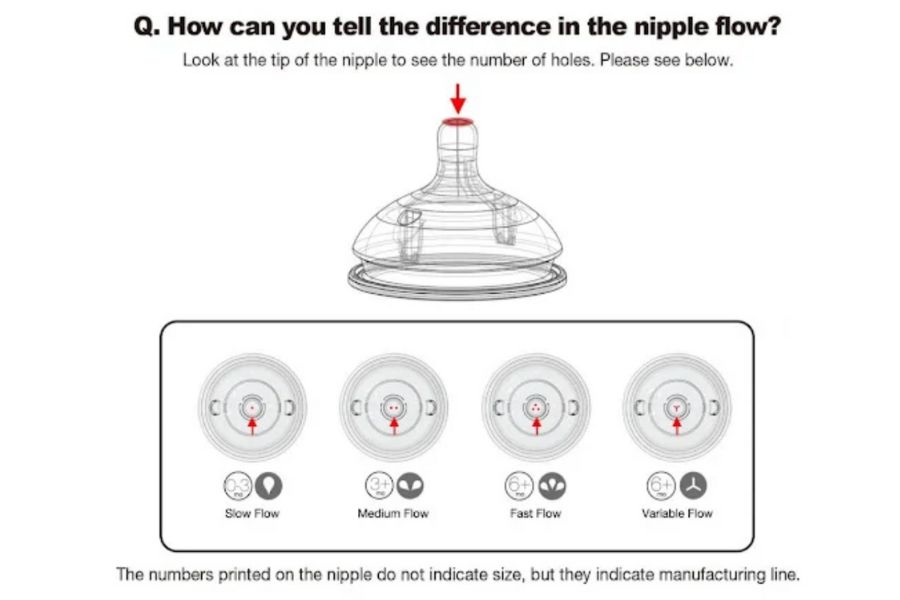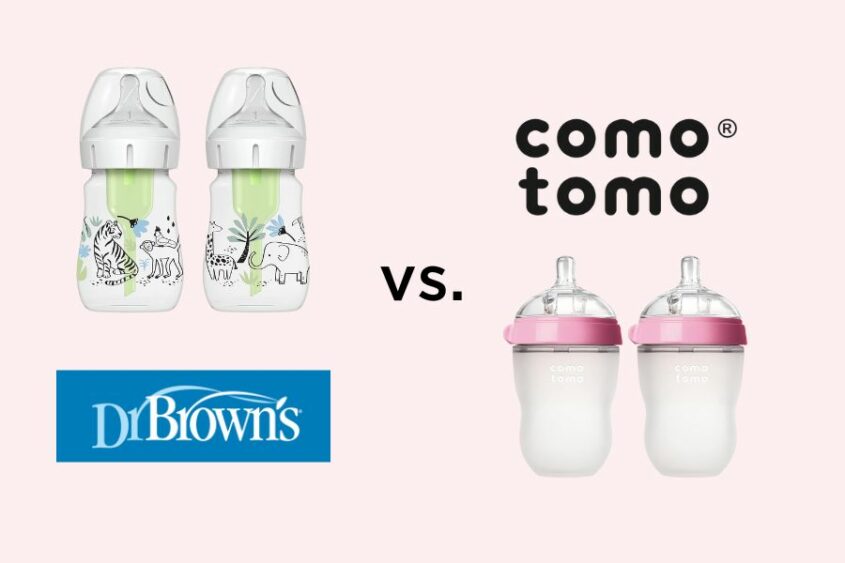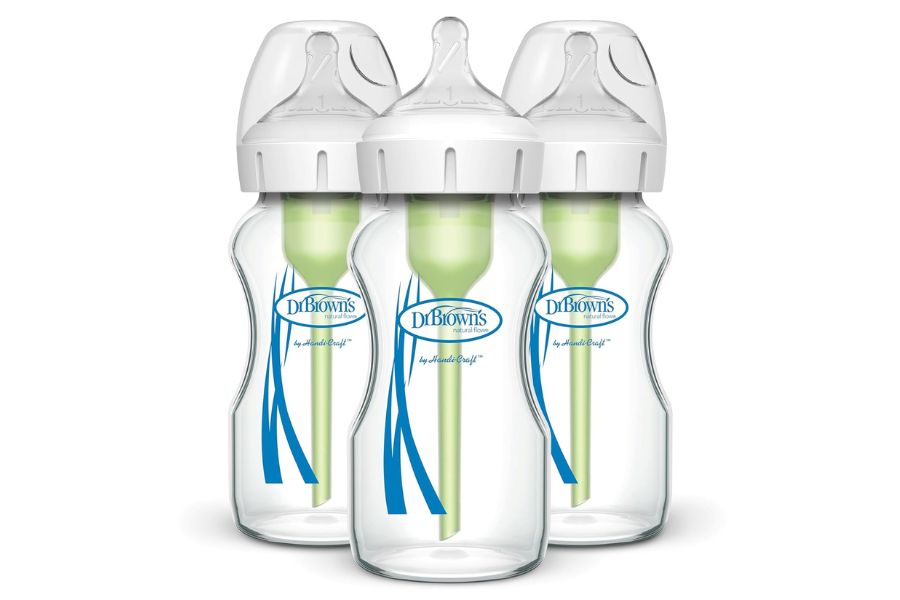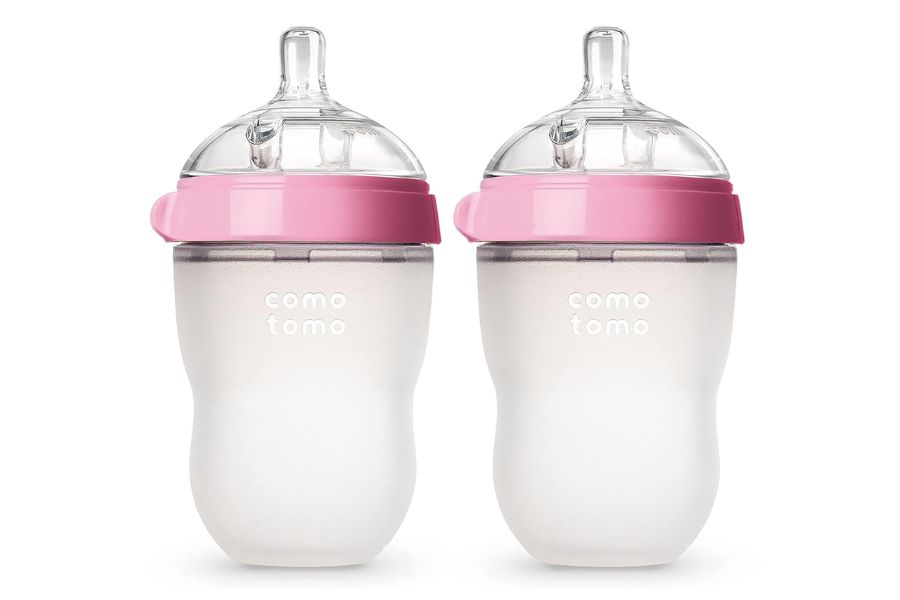Overview
Dr. Brown’s, the brand, is 13 years older than Comotomo. Is older better? Or are the products from the younger brand superior?
We understand how overwhelming it is to choose from so many baby bottle brands. That’s why we’re here to help you learn more about each brand so you can make an educated and empowered decision based on your little one’s preference, budget, and particular situation.
Keep reading this baby bottle review to find thorough comparisons between the most popular choices of these two brands:
- Dr. Brown’s Options+ Baby Bottle (plastic or glass bottles with an internal vent system)
- Comotomo Baby Bottle (silicone bottles with a built-in nipple vent system)
Aside from these, we’ll also share a guide on the factors and tips to consider when choosing your baby’s bottles.
Key Features: Which Baby Bottle Has Better Features?
Brand Reputation
Are Dr Brown’s Superior To Comotomo Bottles?
Established in 1996 by a doctor (yes, Dr. Brown!), Dr. Brown’s bottles may be considered superior or more well-established to the much younger Comotomo in terms of brand reputation.
In 2006 (about 3 years before Comotomo was founded), a Gastroenterology Nursing Journal randomized control trial showed that Dr. Brown’s Natural Flow Baby Bottles helped decrease babies’ time spent fussing and crying. This makes the brand among the first to produce bottles that have been proven to reduce colic. (1)
Is Comotomo Better Than Dr Brown?
Bottles from both brands have different designs, nipple styles, and materials. So, it can be challenging to choose which has better features.
If you prefer a soft silicone that mimics a mom’s breast, then Comotomo can be the superior choice.
Why Do People Love Comotomo Bottles?
Most baby bottles are made of plastic, while others are made of glass. Yet Comotomo offers silicone bottles that make them stand out from the competition.
Silicone bottles are made of safer materials than plastic bottles. They’re also lighter than glass bottles and aren’t prone to breaking. These are some of the reasons why moms choose Comotomo bottles.
Anti-Colic Vent System
Dr. Brown’s has a patented vent system that’s placed inside the bottle. This vent system uses a wand-like attachment to draw air away from your baby’s mouth to reduce the risks of colic, spit-up, and burping.
Even though Dr. Brown’s vent system has been proven effective against colic, many tired parents also express frustration over the number of parts that these bottles have. They’re usually more complicated to assemble, prepare, and clean than most bottle brands.

Thankfully, the vent can be removed in the Options+ bottles (see our review on Dr. Brown’s Green Vs. Blue). But without this vent, the bottle loses most of its anti-colic features.
In contrast, Comotomo uses a dual anti-colic vent system built directly on the bottle nipple. There’s no need to assemble and disassemble the entire thing repeatedly.

We haven’t found studies on how effective Comotomo can be against colic and spit-ups. Still, the brand carries the tagline “Better than good.”
They also claim that they created a whole new category in the baby bottle industry and that their product became a #1 bestseller.
Bottle Material & Options
Dr. Brown’s bottles are made of either glass or BPA-free plastic (without the potentially toxic harmful bisphenol-A).
Comotomo offers silicone bottles that are free from chemicals such as BPA, PVC (polyvinyl chloride), and phthalates.
Nipples: Flow, Style, & Material
Both brands use silicone nipples. Below are their recommendations on the nipple sizes or flow rates.
Here’s from Dr. Brown’s:

This is from Comotomo:

The nipple shape for Dr. Brown’s bottles varies, depending on your choice between narrow or wide-neck bottles.
In contrast, Comotomo only has one nipple shape because the bottles are only available with a wide neck.
Ease Of Use
- Comotomo bottles have fewer parts, making them easier to assemble Dr. Brown bottles
Ease Of Cleaning
Comotomo bottles can be easier to clean because of the following:
- Fewer parts
- Wider mouth
Tip: You can also get an automatic baby bottle washer to cut the time you spend washing and sterilizing your baby’s feeding essentials.
Leakage & Other Issues
- Many consumers who bought Dr. Brown’s and Comotomo bottles complained about leaking from both brands
- Most common reasons for the leakage: an improperly assembled bottle or a blocked anti-colic vent
Value For Your Money
Anti-colic bottles like those from Dr. Brown’s and Comotomo are often pricier than those without these systems. Yet many moms still consider them a value for their money because they help prevent reflux, spit-ups, colic, and other forms of baby discomfort after feeding.
Continue reading for our detailed review below.
Dr. Brown’s Options+ Baby Bottle
Narrow-Neck Plastic Bottle
Wide-Neck Plastic Bottle
Narrow-Neck Glass Baby Bottle
Wide-Neck Glass Bottle
Best Features & Pros
- Material/s: Glass or plastic (BPA-free)
- Sizes Available: 4 oz, 8 oz, or 9 oz (available in wide and narrow neck)
- Ease Of Washing (Dishwasher Safe?): Dishwasher safe (top rack only)
Other Features
- Patented internal anti-colic vent system
- Removable vent (can be used without the vent when your baby no longer needs it)
Cons & Reasons To Avoid
- Can be prone to leaking
- The glass bottles can chip or break
Recalls
- None
What Customers Say
Positive Customer Reviews
“The bottle nipple being shaped like that of a natural nipple makes it so much easier for her to keep a good seal while eating and we have noticed a considerable change in her fussiness after feedings and less gas buildup.” – Reviewer on Amazon
Negative Customer Reviews
“If you get the lid too tight formula gets into the air vent and causes more spit up. It also leaks when formula gets into the air vent. When you loosen the lid to get formula to stay out of the air vent it also leaks.” – Reviewer on Amazon
Comotomo Baby Bottle


 Best Features & Pros
Best Features & Pros
- Material/s: Silicone
- Sizes Available: 5 oz and 8 oz
- Ease Of Washing (Dishwasher Safe?): Easy to clean; can be sterilized in the dishwasher, microwave, electric steamer, and stovetop
Other Features
- Bottle and nipple shape designed to mimic breastfeeding (helps reduce confusion for breastfed babies)
- Wide-neck bottle with built-in nipple air vents
Cons & Reasons To Avoid
- Fewer options or variations to consider
- Not directly compatible with most breast pumps (you might need an adaptor)
- Some complaints that the nipples can get clogged and might not work
Recalls
- None
What Customers Say
Positive Customer Reviews
“With other bottles she would almost choke and spit up/burp a lot but with this one, she controls how fast the milk and formula go which means I hardly have any wasted and the child isn’t choking.” – Reviewer on Amazon
Negative Customer Reviews
“I loved them the first couple of days … but then the nipples were not letting milk out. How frustrating when feeding your newborn in the middle of the night and your baby is fussing and you only come to realize 40min in its because of the stupid nipple and having to get up and replace the nipple with another only to find out that it doesn’t work either!!” – Reviewer on Comotomo
Summary & Recommendations
Both brands offer anti-colic baby bottles for your little one. These different bottles have varied features. Here are our recommendations for new parents:
Choose Dr. Brown’s Options+ Baby Bottle if:
- You prefer an anti-colic vent system that has been trusted for generations
- You prefer to use BPA-free or glass baby bottles
- Your pediatrician recommends using these bottles to reduce your baby’s colic and reflux
- You like to have a baby bottle that can convert into a sippy cup (requires the sippy spout)
- You don’t mind having more parts to assemble and clean
Choose Comotomo Baby Bottle if:
- You prefer a built-in nipple anti-colic system
- You want to consider using a silicone baby bottle
- You want a simpler bottle with fewer parts to clean and assemble
- You want a lighter bottle for your preemie or newborn
FAQs
What Are The Safety Risks To Consider When Choosing Bottle Material?
- Plastic bottles: Harmful chemicals (e.g., BPA and phthalates), if present in the bottle, can seep into your baby’s milk and affect their health
- Glass bottles: Heavier and can be prone to breaking or chipping
- Silicone bottles: Might get deformed with heat and can be more difficult to clean
How Should I Choose My Baby’s Bottle Nipple?
The nipple sizes, codes, or names vary among brands (see illustrations above).
Most baby bottle brands provide slow-flow nipples for the smaller bottles (e.g., 2 oz or 5 oz bottles) and faster flow for the bigger ones. However, it’s ideal to purchase extra nipples with varying sizes to help you easily update the bottle when your baby needs a faster or slower nipple flow.
It’s time to use the next nipple level if your baby:
- Feeds longer
- Appears frustrated and tries to suckle harder or faster while feeding
- Tries to bite on the nipples while feeding
Note that the fewer holes there are, the slower the flow.
If your baby needs a fast-flowing nipple or your pediatrician suggests thickening their formula with cereal, it’s ideal to use the Y-shaped nipple hole.
Can Bottle Feeding Affect My Baby’s Oral Development?
Earlier studies done before the 1990s and the early 2000s showed that bottle feeding can affect oral development, possibly leading to misaligned teeth. (2)(3)
However, more recent studies showed conflicting results, leading some researchers to recommend further studies before drawing conclusions on this issue. (2)(3)
Your pediatrician might recommend weaning your baby and moving to a sippy cup or a small cup when they turn one year old.
How Often Should I Sterilize My Baby’s Bottles?
It’s ideal to use a steam sterilizer to sanitize your baby’s bottles and feeding essentials once a day, particularly if they: (4)
- Are preemies or underweight
- Less than two months old
- Immunocompromised (with a weakened immune system due to an illness)
Should I Get A Silicone Sleeve For My Baby’s Bottles?
Silicone sleeves are meant for glass bottles. They can protect your baby’s glass bottles from breaking and chipping if they accidentally hit something during or after cleaning and feeding.
How Can I Switch Between Breastfeeding & Bottle?
- Consider a baby bottle that mimics breasts and works as if you’re breastfeeding
- If possible, choose a wide-neck bottle
- If you prepare bottles ahead of time, consider getting a bottle warmer so the liquid won’t be cold
- Consider offering breast milk in a bottle before using baby formula
- Relax and let your baby set the feeding pace
- Offer a bottle as close to their regular feeding time as possible, so they’re hungry and more likely to feed than if they’re full
Tips For Choosing Baby Bottles
Consider Anti-Colic Bottles & Their Venting System
Different brands have varied anti-colic venting systems. For example:
- Dr. Brown’s bottles have an internal vent system
- Comotomo features dual built-in nipple vents
- Most Philips Avent bottles only use anti-colic nipples without internal vent systems
- MAM bottles have a vented base
Material & Safety (BPA Controversy & Other Concerns)
Bottles: Size & Shape
Wide-neck bottles have a shape closer to a mom’s breasts, but they can be wide for smaller babies (such as preemies) to hold.
Narrow-neck bottles are easier to hold. However, they might be more challenging to use (or switch) if you also breastfeed your baby. The difference between your nipple and the narrower bottle nipple might confuse them.
Plastics Vs. Glass
Plastic bottles are lighter, more readily available, and usually less expensive than glass bottles. However, they can also contain chemicals used in plastic manufacturing that can harm your baby. Examples include phthalates and BPA.
Glass bottles are heavier and prone to breakage, but they’re also a safer alternative if you want something without chemicals.
Stainless Steel Baby Bottles
- Usually more expensive than plastic and glass bottles
- Can be prone to denting or disfigurement when dropped
- Not readily available for baby bottles
- Might not keep your baby’s milk temperature warm
Nipples
- Silicone is the most common material for the best baby bottle nipples
- Get several nipple sizes because your baby can easily outgrow a slow-flow nipple
Durable & High Quality
Your baby won’t use a bottle forever, yet choosing a high-quality and durable one that can last for months (or even years, if needed) is also ideal. These better bottles help you get your money’s worth for the price you paid.
Doesn’t Leak
It’s frustrating when your baby’s bottle leaks because it can disturb their feeding time.
- Based on customer reviews, leaking is common on Dr. Brown’s bottles
- Leaking in Comotomo bottles is less likely to happen, but some parents still observed it with these bottles
Dr. Brown’s suggests double-checking the valves, collars, and other parts to ensure they’re securely tightened (but not too much) to reduce leaking risks.
Ease Of Assembly & Preparation
- Bottles with an anti-vent system are usually more challenging to assemble and prepare
Ease Of Cleaning
- Having more parts means a longer cleaning time
- Check if the nooks and crannies can be reached by your bottle brush
Other Features To Consider
What If You’re Pumping?
Some bottles (e.g., Medela bottles) are made especially for pumping. You don’t have to get them unless you’re also planning to pump and feed your baby with breastmilk.
Your Budget
You don’t have to get the most expensive baby bottle to prevent colic on your little one. Instead, you can work within your budget and find one that offers the best value for your money.
Online shops and budget stores such as Target, Walmart, and Amazon might also carry these brands at lower prices.
Your Baby’s Preference
In most cases, the last say is from your baby, who might reject or accept the new baby bottle. If possible, try to hold off buying several bottles to fill your diaper bag.
Try buying only a few, then test these baby bottles through trial and error. If your baby chooses a particular style or nipple flow, then you can buy more. This helps prevent working bottles getting rejected because your baby wants another style.
Bottles That Grow With Your Baby
Some bottles can be used from preemie and newborn to toddler age. Consider choosing those that also include options for a sippy spout. These bottles can grow with your baby.
Bonus: Other Baby Bottles To Consider
- Philips Avent Natural Bottle
- Tommee Tippee Closer to Nature Baby Bottle
- MAM Easy Start Anti-Colic Baby Bottle
- Lansinoh Breastfeeding Bottles with Natural Wave Nipple
- NUK Simply Natural Baby Bottle
- Kiinde Active Latch Silicone Baby Bottle
- Medela Breast Milk Bottle
- Evenflo Vented Glass Bottle
- Nanobebe Flexy Silicone Baby Bottle
- Boon Nursh Bottle (with Collapsible Liners)
Other Baby Bottle Feeding Articles & Guides
- Guide: How Many Bottles Do You Need?
- Guide: How To Sanitize Baby Bottles
- Dr. Brown’s Green Vs. Blue
- Dr. Brown’s Vs. MAM Anti-Colic Baby Bottles
- Dr. Brown’s Vs. Philips Avent Bottles
- Dr. Brown’s vs Tommee Tippee
- Top 5 Silicone Brushes
- 12 Best Glass Baby Bottles
- 12 Best Baby Bottles
- Breast Pumps
Recent Baby Product Recalls & Safety Warnings
Stay informed with the latest news by signing up for our regular Motherhood Community recall alerts so you never miss an important recall.
Check these comprehensive lists of product recalls by category:
- Crib recalls (up to 2023)
- Stroller recalls (2020 to 2023)
- Recalled toys list (2020 to 2023)
- Baby formula recall (2001 to 2023)
- Baby food recall (2015 to 2023)
- Pacifier recall (2019 to 2022)
- Baby wipes recall (2014 to 2022)
References
(1) https://pubmed.ncbi.nlm.nih.gov/16770138/
(2) https://pubmed.ncbi.nlm.nih.gov/17003942/
(3) https://www.ncbi.nlm.nih.gov/pmc/articles/PMC8522884/
(4) https://www.cdc.gov/hygiene/childcare/clean-sanitize.html
















